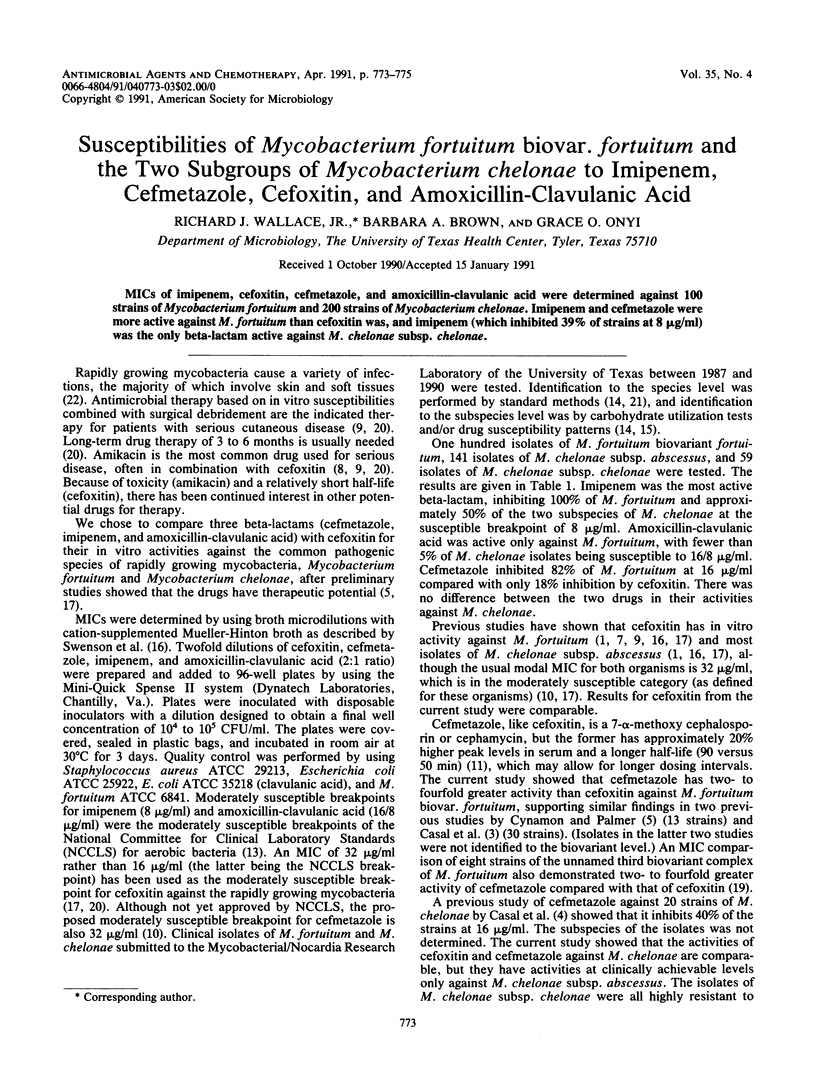Abstract
MICs of imipenem, cefoxitin, cefmetazole, and amoxicillin-clavulanic acid were determined against 100 strains of Mycobacterium fortuitum and 200 strains of Mycobacterium chelonae. Imipenem and cefmetazole were more active against M. fortuitum than cefoxitin was, and imipenem (which inhibited 39% of strains at 8 micrograms/ml) was the only beta-lactam active against M. chelonae subsp. chelonae.
Full text
PDF


Selected References
These references are in PubMed. This may not be the complete list of references from this article.
- Casal M. J., Rodriguez F. C., Benavente M. C. In vitro susceptibility of Mycobacterium fortuitum and Mycobacterium chelonei to cefmetazole. Antimicrob Agents Chemother. 1985 Feb;27(2):282–283. doi: 10.1128/aac.27.2.282. [DOI] [PMC free article] [PubMed] [Google Scholar]
- Casal M., Rodriguez F., Benavente M., Luna M. In vitro susceptibility of Mycobacterium tuberculosis, Mycobacterium fortuitum and Mycobacterium chelonei to augmentin. Eur J Clin Microbiol. 1986 Aug;5(4):453–454. doi: 10.1007/BF02075706. [DOI] [PubMed] [Google Scholar]
- Casal M., Rodríguez F., Gutierrez J., Ruiz P., Benavente M. C., Villalba R., Moreno G. Promising new drugs in the treatment of tuberculosis and mycobacteriosis. J Chemother. 1989 Feb;1(1):39–45. doi: 10.1080/1120009x.1989.11738862. [DOI] [PubMed] [Google Scholar]
- Casal M., Rodríguez F. In vitro susceptibility of mycobacterium fortuitum and mycobacterium chelonei to cefoxitin. Tubercle. 1982 Jun;63(2):125–127. doi: 10.1016/s0041-3879(82)80049-4. [DOI] [PubMed] [Google Scholar]
- Cynamon M. H., Palmer G. S. In vitro susceptibility of Mycobacterium fortuitum to N-formimidoyl thienamycin and several cephamycins. Antimicrob Agents Chemother. 1982 Dec;22(6):1079–1081. doi: 10.1128/aac.22.6.1079. [DOI] [PMC free article] [PubMed] [Google Scholar]
- Cynamon M. H., Palmer G. S. In vitro susceptibility of Mycobacterium fortuitum to amoxicillin or cephalothin in combination with clavulanic acid. Antimicrob Agents Chemother. 1983 Jun;23(6):935–937. doi: 10.1128/aac.23.6.935. [DOI] [PMC free article] [PubMed] [Google Scholar]
- Cynamon M. H., Patapow A. In vitro susceptibility of Mycobacterium fortuitum to cefoxitin. Antimicrob Agents Chemother. 1981 Jan;19(1):205–207. doi: 10.1128/aac.19.1.205. [DOI] [PMC free article] [PubMed] [Google Scholar]
- Dalovisio J. R., Pankey G. A., Wallace R. J., Jones D. B. Clinical usefulness of amikacin and doxycycline in the treatment of infection due to Mycobacterium fortuitum and Mycobacterium chelonei. Rev Infect Dis. 1981 Sep-Oct;3(5):1068–1074. doi: 10.1093/clinids/3.5.1068. [DOI] [PubMed] [Google Scholar]
- Haas H., Michel J., Sacks T. G. In vitro susceptibility of mycobacteria species other than Mycobacterium tuberculosis to amikacin, cephalosporins and cefoxitin. Chemotherapy. 1982;28(1):1–5. doi: 10.1159/000238053. [DOI] [PubMed] [Google Scholar]
- Jones R. N. Cefmetazole (CS-1170), a "new" cephamycin with a decade of clinical experience. Diagn Microbiol Infect Dis. 1989 Sep-Oct;12(5):367–379. doi: 10.1016/0732-8893(89)90106-5. [DOI] [PubMed] [Google Scholar]
- Ko H., Cathcart K. S., Griffith D. L., Peters G. R., Adams W. J. Pharmacokinetics of intravenously administered cefmetazole and cefoxitin and effects of probenecid on cefmetazole elimination. Antimicrob Agents Chemother. 1989 Mar;33(3):356–361. doi: 10.1128/aac.33.3.356. [DOI] [PMC free article] [PubMed] [Google Scholar]
- Nash D. R., Wallace R. J., Jr, Steingrube V. A., Udou T., Steele L. C., Forrester G. D. Characterization of beta-lactamases in Mycobacterium fortuitum including a role in beta-lactam resistance and evidence of partial inducibility. Am Rev Respir Dis. 1986 Dec;134(6):1276–1282. doi: 10.1164/arrd.1986.134.5.1276. [DOI] [PubMed] [Google Scholar]
- Silcox V. A., Good R. C., Floyd M. M. Identification of clinically significant Mycobacterium fortuitum complex isolates. J Clin Microbiol. 1981 Dec;14(6):686–691. doi: 10.1128/jcm.14.6.686-691.1981. [DOI] [PMC free article] [PubMed] [Google Scholar]
- Steele L. C., Wallace R. J., Jr Ability of ciprofloxacin but not pipemidic acid to differentiate all three biovariants of Mycobacterium fortuitum from Mycobacterium chelonae. J Clin Microbiol. 1987 Feb;25(2):456–457. doi: 10.1128/jcm.25.2.456-457.1987. [DOI] [PMC free article] [PubMed] [Google Scholar]
- Swenson J. M., Thornsberry C., Silcox V. A. Rapidly growing mycobacteria: testing of susceptibility to 34 antimicrobial agents by broth microdilution. Antimicrob Agents Chemother. 1982 Aug;22(2):186–192. doi: 10.1128/aac.22.2.186. [DOI] [PMC free article] [PubMed] [Google Scholar]
- Swenson J. M., Wallace R. J., Jr, Silcox V. A., Thornsberry C. Antimicrobial susceptibility of five subgroups of Mycobacterium fortuitum and Mycobacterium chelonae. Antimicrob Agents Chemother. 1985 Dec;28(6):807–811. doi: 10.1128/aac.28.6.807. [DOI] [PMC free article] [PubMed] [Google Scholar]
- Wallace R. J., Jr, Nash D. R., Udou T., Steingrube V. A., Steele L. C., Swenson J. M., Silcox V. A. Isoelectric focusing of beta-lactamases in Mycobacterium fortuitum. Association of a single enzyme pattern with cefoxitin resistance. Am Rev Respir Dis. 1985 Nov;132(5):1093–1097. doi: 10.1164/arrd.1985.132.5.1093. [DOI] [PubMed] [Google Scholar]
- Wallace R. J., Jr, Swenson J. M., Silcox V. A., Bullen M. G. Treatment of nonpulmonary infections due to Mycobacterium fortuitum and Mycobacterium chelonei on the basis of in vitro susceptibilities. J Infect Dis. 1985 Sep;152(3):500–514. doi: 10.1093/infdis/152.3.500. [DOI] [PubMed] [Google Scholar]
- Wallace R. J., Jr, Swenson J. M., Silcox V. A., Good R. C. Disk diffusion testing with polymyxin and amikacin for differentiation of Mycobacterium fortuitum and Mycobacterium chelonei. J Clin Microbiol. 1982 Dec;16(6):1003–1006. doi: 10.1128/jcm.16.6.1003-1006.1982. [DOI] [PMC free article] [PubMed] [Google Scholar]
- Wallace R. J., Jr, Swenson J. M., Silcox V. A., Good R. C., Tschen J. A., Stone M. S. Spectrum of disease due to rapidly growing mycobacteria. Rev Infect Dis. 1983 Jul-Aug;5(4):657–679. doi: 10.1093/clinids/5.4.657. [DOI] [PubMed] [Google Scholar]
- Yew W. W., Kwan S. Y., Wong P. C., Lee J. Ofloxacin and imipenem in the treatment of Mycobacterium fortuitum and Mycobacterium chelonae lung infections. Tubercle. 1990 Jun;71(2):131–133. doi: 10.1016/0041-3879(90)90009-w. [DOI] [PubMed] [Google Scholar]


